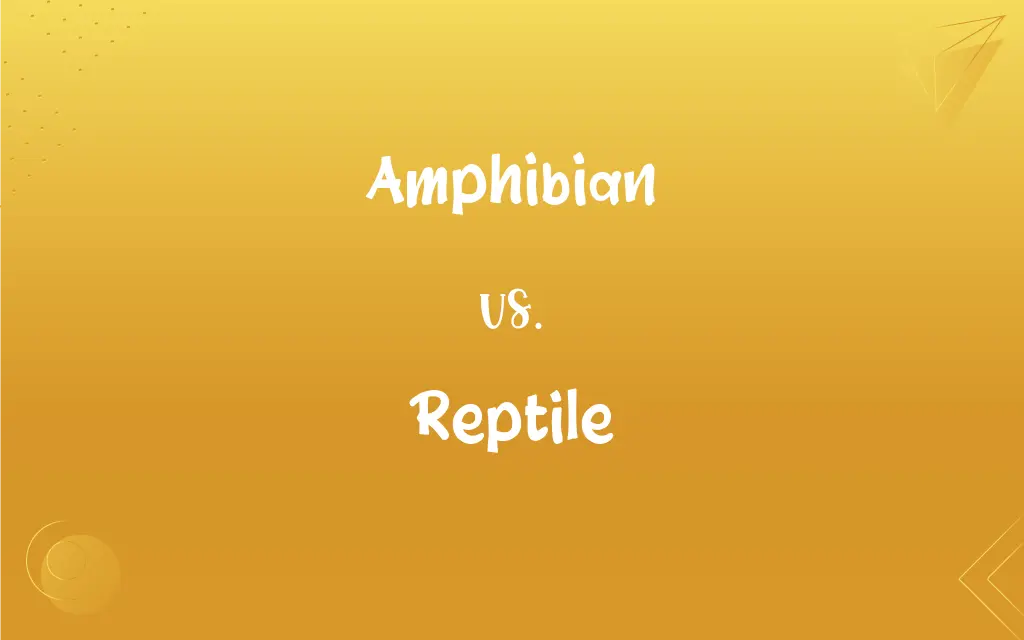Amphibian vs. Reptile: What's the Difference?
Edited by Janet White || By Harlon Moss || Updated on October 18, 2023
Amphibians are cold-blooded vertebrates that live both in water and on land, while reptiles are cold-blooded vertebrates primarily adapted to terrestrial life, with scales.

Key Differences
Amphibians are a group of cold-blooded vertebrates that are distinctive for their dual life stages. Reptiles, on the other hand, are another group of cold-blooded vertebrates, but they primarily live on land and have adapted various features to suit terrestrial life.
Amphibians typically begin their lives in water with gills, transitioning to a terrestrial form with lungs as they mature. Reptiles, conversely, mostly lay shelled eggs on land, and their offspring have lungs from birth.
The skin of an amphibian is usually smooth and moist, which assists in respiration and osmoregulation. Reptiles possess dry, scaly skin which aids in reducing water loss and providing protection.
Amphibians generally lay eggs in water, and these eggs don't have a hard shell. Reptiles usually lay eggs with a tough outer shell on land, or in some cases, give birth to live young.
Both amphibians and reptiles play critical roles in their respective ecosystems. While amphibians are often indicators of environmental health due to their permeable skin, reptiles are key predators and can control the populations of other animals.
ADVERTISEMENT
Comparison Chart
Skin
Smooth and moist
Dry and scaly
Life Stages
Dual life stages (aquatic and terrestrial)
Mostly terrestrial from birth
Eggs
Laid in water, without a hard shell
Laid on land, with a hard shell or live birth
Respiration
Gills in early stages, lungs in later stages
Lungs from birth
Indicative of
Environmental health due to permeable skin
Ecosystem balance as predators
ADVERTISEMENT
Amphibian and Reptile Definitions
Amphibian
A cold-blooded vertebrate that spends its early life in water and adult life on land.
The frog is a common amphibian found in ponds.
Reptile
A vertebrate that usually lays shelled eggs on land.
The turtle, a marine reptile, comes ashore to lay its eggs.
Amphibian
A vertebrate that lays eggs in water which hatch into aquatic larvae.
The newt, an amphibian, lays its eggs among aquatic plants.
Reptile
A cold-blooded vertebrate with dry, scaly skin.
The snake is a reptile that sheds its skin periodically.
Amphibian
An animal capable of living both in water and on land.
The salamander is an amphibian that can navigate aquatic and terrestrial habitats.
Reptile
An animal that primarily inhabits terrestrial environments.
The lizard, a common reptile, basks in the sun on rocks.
Amphibian
A creature that undergoes metamorphosis, transitioning from a larval to adult form.
The tadpole, an amphibian, transforms into a frog as it matures.
Reptile
A creature whose body temperature varies with the environment.
Being a reptile, the alligator relies on external heat sources to regulate its body temperature.
Amphibian
An animal whose temperature regulation is dependent on its environment.
The toad, being an amphibian, requires a moist environment to thrive.
Reptile
An animal equipped with lungs from birth for respiration.
The gecko, a reptile, breathes using its lungs even in its earliest stages of life.
Amphibian
Any of various cold-blooded, usually smooth-skinned vertebrates of the class Amphibia, characteristically hatching as an aquatic larva with gills and then transforming into an adult having air-breathing lungs. Frogs, toads, salamanders, and caecilians are amphibians.
Reptile
Any of various usually cold-blooded egg-laying vertebrates often grouped in the class Reptilia, having dry skin covered with scales or horny plates and breathing by means of lungs, and including the snakes, lizards, crocodilians, and turtles. In some classification systems, birds are considered to be reptiles because they are descended from reptilian dinosaurs.
Amphibian
An animal capable of living both on land and in water.
Reptile
A person regarded as contemptible or obsequious.
FAQs
What distinguishes a reptile?
A reptile is a cold-blooded vertebrate primarily adapted to terrestrial life with scales.
What's a common example of an amphibian?
A common example of an amphibian is a frog.
What is an amphibian?
An amphibian is a cold-blooded vertebrate that lives both in water and on land.
Are reptiles always oviparous (egg-laying)?
While many reptiles lay eggs, some species are viviparous and give birth to live young.
Do reptiles undergo metamorphosis like amphibians?
No, reptiles do not undergo the same metamorphic lifecycle as amphibians.
Are all amphibians able to live on land and in water?
While many amphibians have both aquatic and terrestrial life stages, not all species are equally adept in both environments.
Do amphibians have bones?
Yes, amphibians have a skeletal system, including bones.
How do reptiles contribute to ecological balance?
Reptiles play crucial roles as predators, helping maintain balance by controlling populations of other animals.
Do amphibians have scales?
No, amphibians have smooth, moist skin, while reptiles have scaly skin.
Where do reptiles typically lay their eggs?
Reptiles usually lay their eggs on land with a hard shell.
Which is a famous reptile known for its shell?
The turtle is a well-known reptile recognized for its protective shell.
Why do amphibians need a moist environment?
Amphibians need a moist environment because their skin is permeable and assists in respiration.
Do reptiles have a dual-stage life like amphibians?
No, reptiles do not have a dual-stage life like amphibians; they are primarily terrestrial from birth.
Do amphibians shed their skin?
Yes, many amphibians shed their skin regularly, similar to reptiles.
What role do amphibians play in the ecosystem?
Amphibians are vital indicators of environmental health due to their permeable skin and sensitivity to pollutants.
What's the primary habitat of most reptiles?
The majority of reptiles primarily inhabit terrestrial ecosystems.
Can reptiles live in both freshwater and marine environments?
Yes, while many reptiles are terrestrial, some species inhabit freshwater and marine environments.
Which amphibian is known for its ability to regenerate lost body parts?
The salamander, an amphibian, is renowned for its regenerative capabilities.
Which reptile is known for its long lifespan?
Tortoises, a type of reptile, are known for their notably long lifespans.
How do amphibians breathe during their early life stages?
Amphibians typically use gills to breathe during their aquatic stages.
About Author
Written by
Harlon MossHarlon is a seasoned quality moderator and accomplished content writer for Difference Wiki. An alumnus of the prestigious University of California, he earned his degree in Computer Science. Leveraging his academic background, Harlon brings a meticulous and informed perspective to his work, ensuring content accuracy and excellence.
Edited by
Janet WhiteJanet White has been an esteemed writer and blogger for Difference Wiki. Holding a Master's degree in Science and Medical Journalism from the prestigious Boston University, she has consistently demonstrated her expertise and passion for her field. When she's not immersed in her work, Janet relishes her time exercising, delving into a good book, and cherishing moments with friends and family.































































